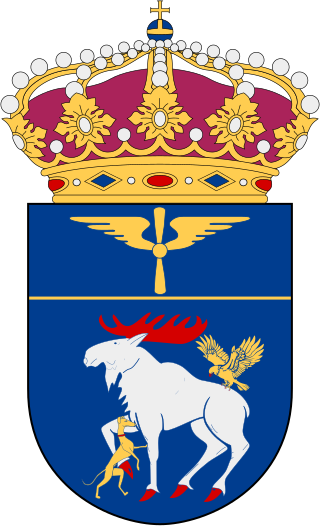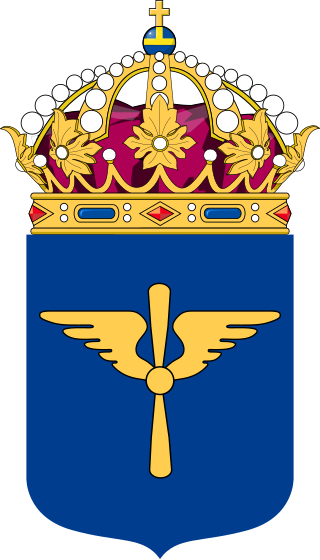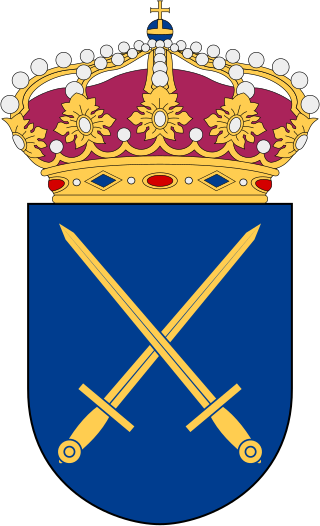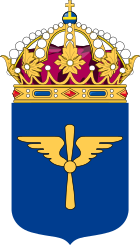
Jämtland Wing, also F 4 Frösön, or simply F 4, is a former Swedish Air Force wing with the main base located at Åre Östersund Airport outside Östersund on Frösön in the middle of Sweden.

Scania Wing, also F 10 Ängelholm, or simply F 10, is a former Swedish Air Force wing with the main base located in southernmost Sweden.

The Chief of Army is the most senior appointment in the Swedish Army. The position Chief of Army was introduced in 1937 and the current form in 2014.

Air Staff is the staff of the Chief of the Swedish Air Force. It was officially established in 1936 due to the Defence Act of 1936 and would handle matters of a general nature. The Air Staff's duties included, among other things, assisting the Chief of the Air Force with the leadership of the Air Force's mobilization, training, tactics, organization, equipment, and personnel to the extent that such activity was not directly related to operational activities, which the Defence Staff then handled. In 1994, the Swedish Armed Forces Headquarters took over the Air Staff's duties. In 2019, the Air Force Staff was re-established in Uppsala Garrison.

The Chief of Navy is the most senior appointment in the Swedish Navy. The position Chief of Navy was introduced in 1936 and the current form in 2014.

Chief of Air Force is the most senior appointment in the Swedish Air Force. The position Chief of Air Force was introduced in 1926 and the current form in 2014.

Maritime Component Command was a part of the Joint Forces Command of the Swedish Armed Forces. The staff was located at the Swedish Armed Forces Headquarters in Stockholm and is headed by the Chief of Navy. The Maritime Component Command commanded the operations of the Swedish Navy forces.
The 1st Air Command, previously named Air Command and later named Attack Command was an air group unit in the Swedish Air Force. The 1st Air Command was the collective name given to the attack wings who would jointly carry out heavier attacks in the event of war. It was active in various formations from 1938 to 1995. It was directly subordinate to the Supreme Commander of the Swedish Armed Forces and therefore nicknamed ÖB:s klubba.

Lieutenant General Jan Ingvar Salestrand is a retired Swedish Air Force officer. Salestrand has served as Chief of Defence Staff, head of the Swedish Armed Forces Headquarters, head of the Swedish Armed Forces Special Forces and as the Commandant General in Stockholm. From 2014 to 2018, he served as State Secretary to the Minister for Defence Peter Hultqvist. From 2018 to 2023, Salestrand served as Chief of His Majesty's Military Staff.
Lieutenant General Jan Bertil Gustav Jonsson was a senior Swedish Air Force officer. Jonsson served as Inspector General of the Air Force from 1998 to 2000, as head of the Joint Forces Command from 2000 to 2007 as well as the Commandant General in Stockholm from 2006 to 2007.

Lieutenant General Mats Evald Nilsson is a Swedish Air Force officer. He served as Inspector General of the Air Force from 2000 to 2002, as head of the Joint Forces Directorate from 2002 to 2007 and as Chief of Defence Staff in 2007. Nilsson served as the First Marshal of the Court from 2012 to 2022.

Land Component Command was a part of the Joint Forces Command of the Swedish Armed Forces. The staff was located at the Swedish Armed Forces Headquarters in Stockholm. The Land Component Command commanded the operations of the Swedish Army.

The Swedish Armed Forces Headquarters is the highest level of command in the Swedish Armed Forces. Established in 1994, its primary task is to command operations, but is also involved in areas such as military strategy, the overall development of the Swedish Armed Forces, and acting as a channel of contact with government. It's located at Lidingövägen 24 at Gärdet in Stockholm.
Major General Kjell Bertil Ingvar Koserius was a Swedish Air Force officer.
Major General Curt Westberg is a retired Swedish Air Force officer. His senior commands include commanding officer of the Gotland Military District, Central Military District as well as Commandant General in Stockholm.
Major General Bernt Nils Sune Östh was a Swedish Air Force officer. Östh served as Chief of the Air Staff from 1990 to 1994 and as chief of the Joint Staff at the Swedish Armed Forces Headquarters from 1994 to 1997.
The Swedish Armed Forces Helicopter Wing organizes all Swedish Armed Forces military helicopter operations. The unit was formed in 1998 by merging the Army, Air Force and Navy helicopter resources. The unit is located in three places in Sweden, with headquarters at Malmen Airbase in Linköping.
The Central Air Command was an air command within the Swedish Air Force that operated from 1994 to 2000. The unit was based in Bålsta in Uppsala Garrison. It was responsible for air surveillance over Central Sweden.
The Northern Air Command was an air command within the Swedish Air Force that operated from 1994 to 2000. The unit was based in Luleå in Luleå Garrison. It was responsible for air surveillance over northern Sweden.
The Southern Air Command was an air command within the Swedish Air Force that operated from 1994 to 2000. The unit was based in Ängelholm. It was responsible for air surveillance over South Sweden.













